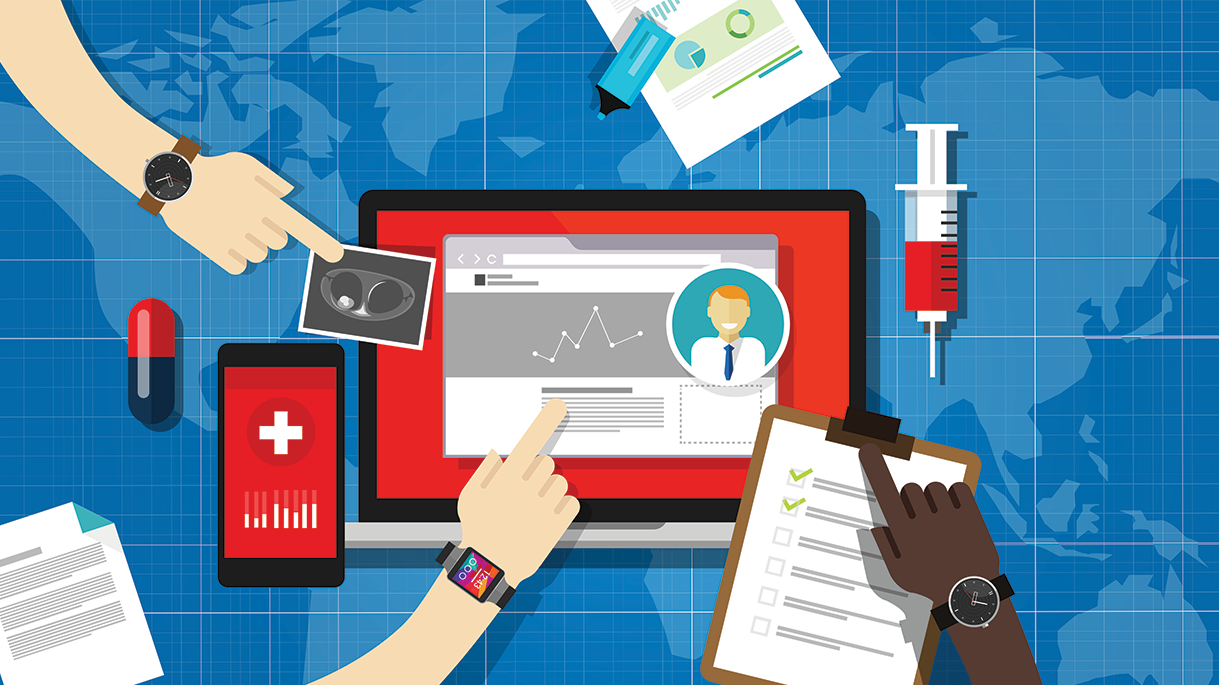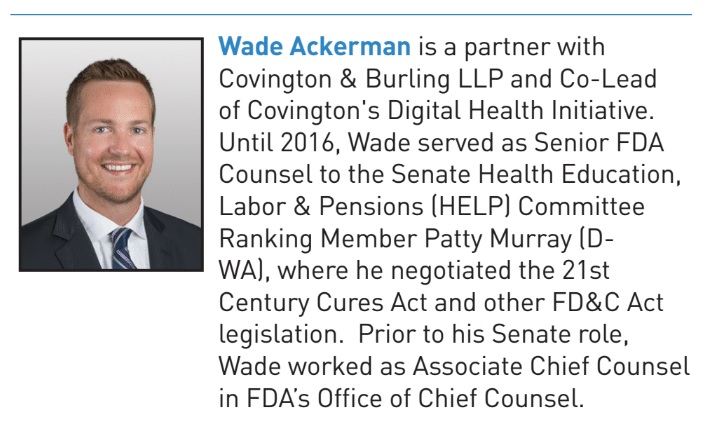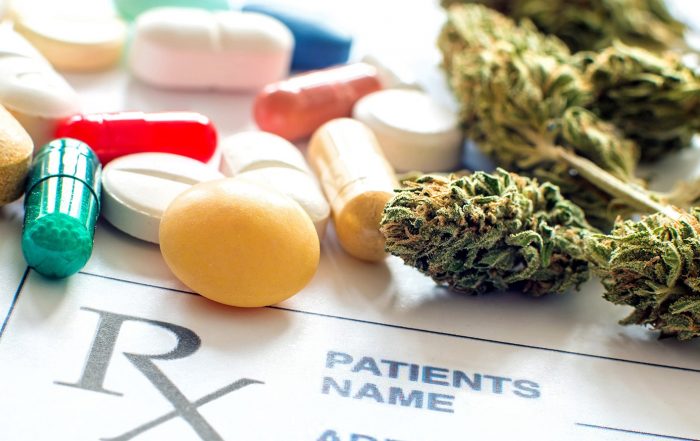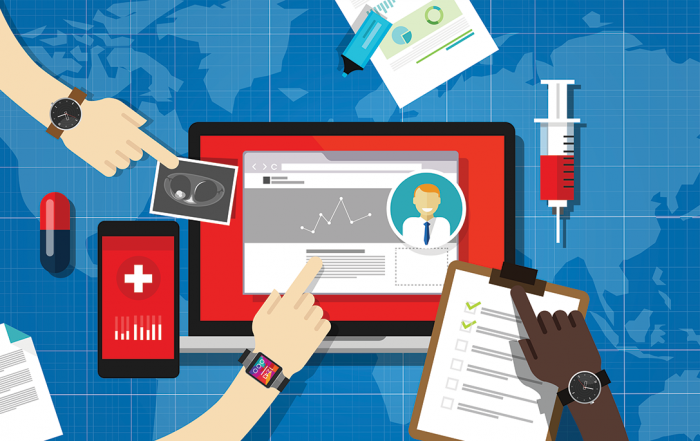
Digital Health – FDA’s Approach will Continue to Evolve
by Wade Ackerman
The term “digital health” gets thrown around a lot, and it means different things to different people. I view the term broadly as the application of digital technology to our health and wellness. We have an array of new sources of health data, and with evolving computing capabilities, we now can create, store, manipulate, and analyze large amounts of information like never before possible. It is not difficult to see how digital technology is already integrating into existing models of health care—an app that a doctor uses to help diagnose an illness, for example, or software embedded in an inhaler that tracks usage and lets a patient know about a missed dose. Digital health tools can guide users toward behavioral changes to help prevent or manage disease, or an app may take certain actions for a user (e.g., schedule a visit to the doctor, order or administer medicine). Pharmaceutical innovators are also deploying digital health tools with artificial intelligence to help with drug development and clinical trials. Many other exciting possibilities have yet to be imagined. Digital health promises to change health care as we know it, and FDA’s role in digital health will continue to evolve.
A digital health sponsor’s first question related to FDA typically should be whether a digital health tool will be regulated as a “device.” FDA’s Center for Devices and Radiological Health (CDRH) has explained in guidance documents and other sources which digital health tools the agency will regulate as devices and how FDA expects to regulate those tools.
A common misconception is that digital health is purely a “device” issue. As digital technology integrates into more and more aspects of FDA-regulated products—such as apps deployed by drug sponsors, digital health solutions used in combination with an approved drug, or tools aimed at helping consumers choose a supplement or cosmetic—other FDA centers also play a role in regulating digital health. Thus, depending on who you are or how you plan to use digital health, a second question is whether the tool implicates another FDA-regulated product or implicates regulatory responsibilities associated with the other product (that is, unless FDA provides guidance otherwise).
Several years ago, while serving as counsel to the Senate Health, Education, Labor and Pensions Committee, I worked with incredibly talented colleagues on both sides of the aisle to negotiate the 21st Century Cures Act; a similar process took place in the House E&C Committee, which also has jurisdiction over the Federal Food, Drug and Cosmetic Act (FDCA).1 During the Cures process, congressional members and staff spent about two years examining the cutting-edge of medical innovation, hearing from researchers, patient and consumer groups, industry and other key stakeholders. As most readers will know, President Obama signed the Cures Act into law on December 13, 2016. Section 3060 of the Cures Act addresses FDA’s regulation of digital health tools. Currently, Commissioner Gottlieb frequently remarks how the Cures Act created a modern framework to build on FDA’s approach to medical product regulation.
Behind the curtain, the digital health provisions of the Cures Act were some of the most intensely negotiated. Countless hours were spent with FDA staff, technology and life sciences innovators, patient groups, and others, deliberating the future of digital health and the appropriate regulatory approaches. Section 3060 of the Cures Act was the result of that effort, and since its passage, FDA has been implementing the digital health framework outlined by the new law.
In parallel, and less than a year after Congress passed the Cures Act, FDA began piloting a precertification program for digital health. Led by CDRH, the precertification pilot program focuses FDA’s attention on the entity producing a digital health product. By certifying that a particular digital health developer exercises quality and organizational excellence, FDA would offer a more streamlined pathway to market for the developer’s products. This is a shift from FDA’s usual approach to regulation. With only a few exceptions, FDA focuses primarily on products—is a drug safe and effective, is a 510(k) device substantially equivalent to a predicate device, is an article adulterated or misbranded under the FDCA. Instead, the precertification pilot program’s primary focus would be around the entity producing a regulated product and its processes for developing and deploying digital health tools.
FDA intends to finalize the precertification model and expand the program beyond the pilot in early 2019. Some have asked what statutory authorities FDA plans to use to outline the program, and depending on what FDA says, this could result in an interesting discussion at next year’s FDLI Annual Conference. Moreover, I suspect that Congress will consider digital health again at some point. While the Cures Act has been an important chapter, digital technologies continue to evolve, and Congress may decide to address one or more digital health issues, such as FDA regulation or precertification, reimbursement, liability or data privacy/security. Whether the next legislative chapter will be 21st Century Cures 2.0, or part of the next medical product user fee reauthorization in 2022, remains to be seen.
When I think about how FDA’s role in digital health will evolve, I work backwards. Much of today’s discussion is about specific apps, clinical and patient decision support tools, or artificial intelligence and machine learning. Tomorrow’s consumers can be expected to want all beneficial digital health tools at their fingertips—real-time and integrated—in order to better understand and manage their health and wellness. Smartphones (or their successors) will be connected to smart homes, smart cars, and smart offices, to continually monitor and analyze health, wellness, and behavioral data. These tools will incorporate information about the use of pharmaceuticals and traditional medical devices and will leverage the insights gained from use of digital health tools across the population. Patient contacts with the health care system and “health records” will not be limited to a doctor’s visit or trip to the ER; instead, digital health tools will surround our daily lives. recommending or refilling medications at clinically appropriate times, recognizing diseases at their earliest stages, prescribing behavioral changes to help prevent disease, connecting and enrolling patients in clinical trials, keeping seniors at home instead of a nursing facility, even ordering a food or fitness regime based on genetic and other personalized information. People will be able to better manage their own health and the health of their family members—staying well, preventing disease where possible, ensuring the right interventions are deployed at the right time. The possibilities go on, and continued thought should be given to the appropriate regulatory approaches at FDA. Strong coordination across the agency is also important, as digital technologies integrate into more and more FDA-regulated products.
Significant commercial questions also remain about which industry players will take leading roles as digital health proliferates throughout the health care and life sciences ecosystem. Will providers and health care systems play different roles in our health? How will payors value these tools? How will information about pharmaceuticals or traditional devices be integrated into clinical and patient decision-making? How do we handle data privacy and security issues presented by these technologies?
Just as digital technologies have disrupted other industries, digital health will change the health care system as we know it. It may take some time—the health care system is large and complex. But the promise of digital health is real, and there are many reasons to be excited about all that it will do for public health. Stakeholders should consider an active role in ongoing policy development, as the framework for digital health is being crafted in real time. FDA’s own activity on the digital health front is an indication that the agency is aware of how expansive and integral digital health technologies will be to our lives. This future isn’t that far away.
Update Magazine
October/November 2018
- For those less familiar with the Cures Act, the Senate HELP Committee Chairman Alexander and Ranking Member Murray (my boss at the time) spent considerable time in 2015-16 exploring ways for Congress to help usher in the new era of precision medicine and help advance the development of new therapies for patients. The Senate process built upon efforts in the House of Representatives by E&C Committee Chairman Upton, Ranking Member Pallone and Rep. DeGette.







